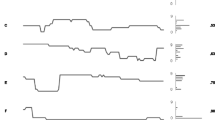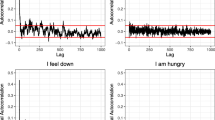Abstract
A non-linear perspective may be relevant to understanding mental disorders, particularly in primary care settings. There is growing evidence that variability in heart rate and mood over time, that non-linearity of a variety of parameters (from heart rate to mood), and that the degree of co-variability of anxiety and depression may be relevant to our understanding of what constitutes mental health and illness as well as their outcomes. In a small study (n = 15) of adult primary care patients with major depressive disorder, panic disorder, or neither disorder, patients recorded hourly levels of anxiety and depression while awake for 4 weeks. Analysis of data employed measures of non-linearity as well as state space grid analysis. Eleven subjects completing the mood diary had missing data rates of 0–2.4 %. Results showed that all three groups differed in their patterns of mood variability and anxiety–depression co-variability. These results suggest that healthy mood variability includes both linear and non-linear components, and that mental illness may represent a disturbance in either of these components or in the coupling between different moods. Such a proposed model is based upon the linear–non-linear relationships between symptoms of anxiety and depression, and how these dynamics change as illness severity increases. If true, then non-linear dynamics may have important clinical implications for classification of mental disorders (necessitating revision in diagnostic approaches and the classification of mental disorders), identification of novel treatments (small but well-timed, pulse interventions or multifaceted, whole patient approaches), and monitoring of dynamics (i.e., cardiac monitoring) and response. For this reason, a dynamical systems approach has been advocated for psychiatrists and psychologists alike, but such advice may be of particular importance to primary care physicians. However, these implications are based upon preliminary evidence that a non-linear, dynamical basis for classification and treatment of mental disorders is more parsimonious than the current linear, symptom level model. Further investigations are needed to assess whether a non-linear, dynamical framework may provide us with a new, yet rewarding, perspective for understanding the emergence and evolution of mental illness.
Access this chapter
Tax calculation will be finalised at checkout
Purchases are for personal use only
Similar content being viewed by others
References
Klinkman M, Schwenk T, Coyne J. Depression in primary care-more like asthma than appendicitis. Can J Psychiatry. 1997;42:966–73.
Wells KB, Burnam A, Camp P. Severity of depression in prepaid and fee-for-service general medical and mental health specialty practices. Med Care. 1995;33:350–64.
Albrecht G, Freeman S, Higginbotham N. Complexity and human health. Cult Med Psychiatry. 1998;22(1):55–92.
Thomasson N, Pezard L. Dynamical systems and depression. Acta Biotheor. 1999;47:209–18.
Belair J, Glass L, van der Heiden U, Milton J, editors. Dynamical disease: mathematical analysis of human illness. Woodbury, NY: American Institute of Physics; 1995.
Heath RA. Complexity and mental health. In: Holt TA, editor. Complexity for clinicians. Abingdon: Radcliffe; 2004.
Warren K, Sprott JC, Hawkins RC. Spirit is willing. Nonlinear Dynamics Psychol Life Sci. 2002;6:55–70.
Koopmans M. Chaos theory and the problem of change in family systems. Nonlinear Dynamics Psychol Life Sci. 1998;2:133–48.
Pincus D. A framework and methodology for the study of nonlinear, self-organizing family dynamics. Nonlinear Dynamics Psychol Life Sci. 2001;5:139–73.
Katerndahl DA, Burge SK, Ferrer RL, Becho J, Wood R. Dynamics of violence. J Eval Clin Pract. 2014;20:695–702.
Ehlers CL. Chaos and complexity. Arch Gen Psychiatry. 1995;52:960–4.
Guastello SJ. Nonlinear dynamics in psychology. Discret Dyn Nat Soc. 2001;6:11–29.
Morrison F. Art of modeling dynamic systems. New York: Wiley; 1991.
Hirsch IB, Brownlee M. Should minimal blood glucose variability become the gold standard of glycemic control? J Diabetes Complicat. 2005;19:178–81.
De Vries MW, Dijkman-Caes CIM, Delespaul PAEG. Sampling of experience. In: Maser JD, Cloninger CR, editors. Comorbidity of mood and anxiety disorders. Washington, DC: American Psychiatric Association; 1990.
Kendler KS, Neale MC, Kessler RC, Heath AC, Eaves LJ. Familial influences on the clinical characteristics of major depression. Acta Psychiatr Scand. 2007;86:371–8.
Fone D, Dunstan F, Lloyd K, Williams G, Watkins J, Palmer S. Does social cohesion modify the association between area income deprivation and mental health? Int J Epidemiol. 2007;36:1–8. doi:10.1093/ije/dym004.
Pincus SM. Approximate entropy as a measure of irregularity for psychiatric serial metrics. Bipolar Disord. 2006;8:430–40.
Yeragani VK, Radhakrishna RKO, Tancer M, Uhde T. Nonlinear measures of respiration. Neuropsychobiology. 2002;46:111–20.
Caldirola D, Bellodi L, Caumo A, Migliarese G, Perna G. Approximate entropy of respiratory patterns in panic disorder. Am J Psychiatry. 2004;161:79–87.
Yeragani VK, Rao R, Tancer M, Uhde T. Paroxetine decreases irregularity of linear and nonlinear measures of respiration in patients with panic disorder. Neuropsychobiology. 2004;49:53–7.
Pezard L, Nandrino JL, Renault B, El Massioui F, Allilaire JF, Muller J, et al. Depression as a dynamical disease. Biol Psychiatry. 1996;39:991–9.
Thomasson N, Pezard L, Allilaire JF, Renault B, Martinerie J. Nonlinear EEG changes associated with clinical improvement in depressed patients. Nonlinear Dynamics Psychol Life Sci. 2000;4:203–18.
Yeragani VK, Pohl R, Mallavarapu M, Balon R. Approximate entropy of symptoms of mood. Bipolar Disord. 2003;5:279–86.
Yeragani VK, Rao KAR. Nonlinear measures of QT interval series. Psychiatry Res. 2003;117:177–90.
Rao RKA, Yeragani VK. Decreased chaos and increased nonlinearity of heart rate time series in patients with panic disorder. Auton Neurosc. 2001;88:99–108.
Yeragani VK, Mallavarapu M, Radhakrishna RKA, Tech M, Tancer M, Uhde T. Linear and nonlinear measures of blood pressure variability. Depress Anx. 2004;19:85–95.
Yeragani VK, Rao KAR, Pohl R, Jampala VC, Balon R. Heart rate and QT variability in children with anxiety disorders. Depress Anx. 2001;13:72–7.
Srinivasan K, Ashok MV, Vaz M, Yeragani VK. Decreased chaos of heart rate time series in children of patients with panic disorder. Depress Anx. 2002;15:159–67.
Bob P, Kukleta M, Riecansky I, Susta M, Kukumberg P, Jagla F. Chaotic EEG patterns during recall of stressful memory related to panic attack. Physiol Res. 2006;55(1):S113-9.
Kubota S, Sakai K. Relationship between obsessive-compulsive disorder and chaos. Med Hypotheses. 2002;59:16–23.
Schuldberg D, Gottlieb J. Dynamics and correlates of microscopic changes in affect. Nonlinear Dynamics Psychol Life Sci. 2002;6:231–57.
Johnson SL, Nowak A. Dynamical patterns in bipolar depression. Personal Soc Psychol Rev. 2002;6:380–7.
Sarbadhikari SN, Chakrabarty K. Chaos in the brain. Med Eng Phys. 2001;23:445–55.
Han DH, Renshaw PF, Dager SR, Chung A, Hwang J, Daniels MA, et al. Altered cingulated white matter connectivity in panic disorder patients. J Psychiatr Res. 2008;42:399–407.
Cecen AA, Erkal C. Long march: from monofractals to endogenous multifractality in heart rate variability analysis. Nonlinear Dynamics Psychol Life Sci. 2009;13:181–206.
Combs A, Winkle M, Daley C. Chaotic systems analysis of rhythms in feeling states. Psychol Record. 1994;44:359–68.
Woyshville MJ, Lackamp JM, Eisengart JA, Gilliland JAM. On the meaning and measurement of affective instability. Biol Psychiatry. 1999;45:261–9.
Hall DP Jr., Sing HC, Romanoski AJ. Identification and characterization of greater mood variance in depression. Am J Psychiatry. 1991;148:1341–5.
Heiby EM, Pagano IS, Blaine DD, Nelson K. Modeling unipolar depression as a chaotic process. Psychol Assess. 2003;15(3):426–34.
Katerndahl D, Ferrer R, Best R, Wang CP. Dynamic patterns in mood among newly-diagnosed patients with major depressive episode, panic disorder, and normal controls. Prim Care Comp J Clin Psychiatry. 2007;9(3):183–7.
Katerndahl D, Wang CP. Dynamic co-variation of symptoms of anxiety and depression among newly-diagnosed patients with major depressive episode, panic disorder and controls. Nonlinear Dynamics Psychol Life Sci. 2007;11(3):349–65.
Barlow DH, Campbell LA. Mixed anxiety-depression and its implications for models of mood and anxiety disorders. Compr Psychiatry. 2000;41(suppl. 1):55–60.
Katerndahl DA. Power laws in covariability of anxiety and depression among newly-diagnosed primary care patients with major depressive disorder, panic disorder and controls. J Eval Clin Pract. 2009;15:565–70.
Toro MG, Ruiz JS, Talavera JA, Blanco C. Chaos theories and therapeutic commonalities among depression, Parkinson’s disease, and cardiac arrhythmias. Compr Psychiatry. 1999;40:238–44.
Hanaoka A, Kikuchi M, Komuro R, Oka H, Kidani T, Ichikawa S. EEG coherence analysis in never-medicated patients with panic disorder. Clin EEG Neurosc. 2005;36:42–8.
Dahlgren A, Akerstedt T, Kecklund G. Individual differences in the diurnal cortisol response to stress. Chronobiol Int. 2004;21:913–22.
Healy D, Williams JMG. Dysrhythmia, dysphoria, and depression. Psychol Bull. 1988;103:163–78.
Sussman EJ, Dorn LD, Inoff-Germain G, Nottelmann ED, Chrousos GP. Cortisol reactivity, distress behavior, and behavioral and psychological problems in young adolescents. J Res Adoles. 1997;7:81–105.
Sabelli HC. Bios: a study of creation. New Jersey: World Scientific; 2005.
Yeragani VK, Nadella R, Hinze B, Yeragani S, Jampala VC. Nonlinear measures of heart period variability. Depress Anx. 2000;12:67–77.
Scheffer M, Bascompte J, Brock WA, Brovkin V, Carpenter SR, Dakos V, et al. Early-warning signals for critical transitions. Nature. 2009;461:53–9.
Glenn T, Whybrow PC, Rasgon N, Grof P, Alda M, Baethge C, Bauer M. Approximate entropy of self-reported mood prior to episodes in bipolar disorder. Bipolar Disord. 2006;8:424–9.
Tschacher W. Dynamics of psychosocial crises. J Nerv Ment Dis. 1996;184:172–9.
Nagayama H. Influences of biological rhythms on the effects of psychotropic drugs. Psychosom Med. 1999;6:618–29.
Kraft M, Martin RJ. Chronobiology and chronotherapy in medicine. Disease-A-Month 1995;41:503–75.
Christini D, Collins J, Linsay P. Experimental control of high dimensional chaos. Phys Rev E. 1996;54:4824–7.
Author information
Authors and Affiliations
Corresponding author
Editor information
Editors and Affiliations
Rights and permissions
Copyright information
© 2016 Springer International Publishing Switzerland
About this chapter
Cite this chapter
Katerndahl, D.A. (2016). Viewing Mental Health Through the Lens of Complexity Science. In: Sturmberg, J. (eds) The Value of Systems and Complexity Sciences for Healthcare. Springer, Cham. https://doi.org/10.1007/978-3-319-26221-5_11
Download citation
DOI: https://doi.org/10.1007/978-3-319-26221-5_11
Published:
Publisher Name: Springer, Cham
Print ISBN: 978-3-319-26219-2
Online ISBN: 978-3-319-26221-5
eBook Packages: MedicineMedicine (R0)




